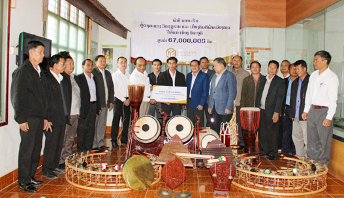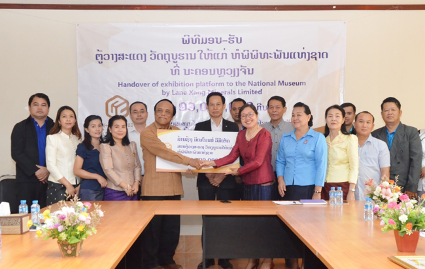Lane Xang Minerals Limited Sepon extends support to cultural heritage preservation in Laos
March 23, 2020
Lane Xang Minerals Limited Sepon (LXML) recently handed artefacts exhibition stands valued over US$25,000 to the Lao National Museum, Savannakhet Museum, and Vilabouly Cultural Hall in a bid to preserve and further promote ancient artefacts discovered at Sepon Mine, Vilabouly district, Savannakhet province. This is an outcome from LXML’s decade-long support to the Lao Government in archaeological research and cultural heritage preservation.
In September of last year, LXML handed over more than 7,800 artefacts to the Lao Government. These artefacts – made up from copper, bronze, chalcedony (regular gems), ceramic, wood among others – have been discovered on site at Sepon mine. These ancient artefacts are valuable additions to prehistoric Lao cultural heritage.
“LXML is proud to partake in the support and preservation of national heritage and attract tourism into Laos” said Mr Saman Aneka, LXML Managing Director and Stakeholder and Communications Manager. “We are committed to modelling mining excellence by respecting local cultures.”
Since 2008, LXML has invested over US$1.3 million in supporting 3,000 years of Lao history and heritage through our archaeological research with the Department of Heritage (DoH) of the Ministry of Information, Culture and Tourism, the National University of Laos, and James Cook University of Australia. The program sponsors fieldwork that unites a unique community at local, national and international levels. Volunteers from Vientiane, local villagers, Australian and Lao students, archaeologists and Lao officials from the DoH stationed at Sepon mine cooperate closely to conduct research.
“The cooperation between the Department of Heritage and LXML is a one-of-a kind partnership” said Mr Thongbay Photisane, Director General of Department of Heritage. “It is a full on support by the company that significantly contributes to the Lao people as well as our tourists. We can compare this support to ‘gold’ as it has economic and reputational value, of which tourists who see our displays can go back home and tell their friends to come visit its points of origin.”
Remarkable discoveries of artefacts and heritage sites have been made at the Sepon mine in the Vilabouly District, Savannakhet Province. In March 2018, the team of archaeologist discovered evidence of more than 200 antic mine shafts dating back over 3,000 years ago. This means Vilabouly district is considered one of the first mining and metallurgy areas in Southeast Asia. We believe ancient mining around Sepon mine continued to about 1,300 years ago (700 AD) where people have excavated the rich copper ore then refined it in the so-called Peun Baolo and Thong Na-Gneuak (Dragon Field) locations and exchanged minerals and metals since then. These dates have been confirmed from the examination of bamboo matting found in the mentioned well-preserved ancient mine-shaft support structures laid in the compacted wet clay just below the surface (10 to 40 meters deep).
Other artefacts unearthed include mining equipment such as wooden ladders, pulleys, mallets, painted bamboo baskets, and rope made from lianas; a large ‘Dong Son’ bronze era drum currently on display at the National Museum in Vientiane; and crucibles, copper ingots, jewellery, ceremonial items and other artefacts highlighting Laos’ pivotal place in regional history.
Mining has been essential in the development of civilisation and society throughout history. Excavations will continue and we look forward to reveal more exciting discoveries about Lao culture and history.






